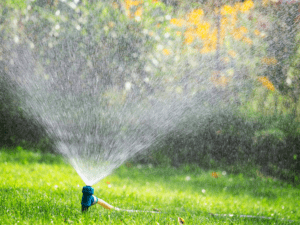Best Time to Water Your Lawn and other Watering Tips
Best Time to Water Your Lawn and other Watering Tips
Proper Watering & Mowing is essential to a Green, Thick and Healthy Lawn.
Here are the facts for watering lawns in the Greater Toronto Area (and similar growing districts with cool-season grass varieties)
When is the Best Time to Water Your Lawn?
The best time to water grass is in the early morning. The 2nd best time is RIGHT NOW! Watering in the morning is best because this allows the water to soak deep into the soil (without evaporation) and allows the leaves of the grass plant to dry before the water evaporates once it gets warmer in the day. If you can’t water in the morning, evenings are OK, just don’t make a habit of it! (Better to water any time, than not water at all).
How Many Times a Week Should You Water Your Lawn?
When it comes to the best ways to water your grass you need to water at least once a week for at least an hour in each area, this generally provides 1-1.5″ of water to the roots (a tuna cans height) (exceptions: 1. when you seed & 2. if you have an automated (in-ground) system 3. When we are experiencing extreme heat).
New Seeding Watering: Seed must be kept moist until established. This will be influenced by the amount of sun, wind and heat you are experiencing in your particular area. It is normal to require 3-4 short watering’s per day to maintain a moist seedbed. Use a light stream of water to lessen disturbance of the seedbed.
Why Do You Need to Water Your Lawn?
The deeper the roots- the less often you will need to water- and a healthier lawn withstands drought. Deep watering actually encourages deeper roots as they grow deeper into the soil to search for water.
Deep roots enjoy the lower soil temperatures during the heat of the summer and less fluctuations in moisture levels and temperature.
How Much Water Do You Use When You Water Your Lawn?
All lawn areas require 1”- 1.5″ per week. This is best done in one to two watering’s per week depending on your soil type and if we are experiencing heat waves (temps above 28 deg. C for more than 2 days in a row). The trick here is to water deeply so that the roots grow down deeper into the soil to chase the water, thereby leaving more soil above them to protect them during periods of dryness and excessive heat. (Sandy soils drain quicker, therefore must be watered more frequently.)
GREAT TIP!!
Use a timer to make sure you water your grass at the best time for your lawn.
Hose end or hose-bib timers are available at major retail hardware stores and allow you to water your lawn while not at home. Simply attach to your tap before you attach your hose. When you leave in the morning, set your sprinkler out at the desired location, turn the timer on to 60-120 minutes and leave for the day. You can rest assured that the lawn will get the water it needs and you don’t have to remember to shut it off.
Time to invest in an automated Irrigation System?
For over 15 years, LawnSavers professionally installed sprinkler systems in house for our clients. Although we no longer install or maintain systems, we still offer a wealth of plant-based knowledge to help you optimally tune your sprinkler system for healthy turf and plant growth, Check out our blog, it has lots of great sprinkler information on how to find a professional automatic lawn irrigation contractor.
More Lawn Watering Advice
It is extremely important that a newly seeded lawn be kept moist but NOT SATURATED, until the seeds begin to grow. After the seeds have germinated and have begun to establish a root system, reduce the frequency of watering. Applying too much water will only inhibit germination and promote disease. As you reduce the watering frequency you should also increase the amount of water applied each time.
In 6-8 weeks after planting seed, you can treat your lawn like an established lawn.
How Much Water Do You Use When You Water Your Lawn?
Deep, infrequent watering is typically best for most lawns. On average, a lawn needs about 1 inch of water a week during the growing season, either from rain or irrigation. This 1 inch of water normally soaks the soil to a depth of 4-6 inches, which allows the water to reach deep into the root system.
You must determine the rate of application of your sprinkler system to set up any irrigation program. An easy way to determine the rate of your sprinkler system is to set out a series of equal sized containers (tuna cans, bowls, etc.) if you use a single sprinkler. Run the system for 30 minutes and then measure the amount of water in the can and adjust your watering time to reach the desired level. With this little “can test” and a little simple math you can determine the length of time it takes to apply 1 inch of water.
Do You Need to Worry About Water Runoff?
Watch for runoff during the watering period. It is very possible that your lawn will not be able to soak up the water as fast as your sprinkler is putting it on the lawn. If this occurs shut off the sprinkler for an hour and then turn it on again. If you have an automatic system, have it cycle through the stations again.
Also, remember that sloped areas will have more tendencies for runoff. The best times to water your lawn is in the early morning or early evening when there is generally less wind and heat. The least desirable times are in the heat of the afternoon, when water evaporates too quickly and very late in the evening, which can cause the lawn to stay wet all night. This may encourage disease development.
As each lawn area is unique, there are no formulas or automatics for determining a watering schedule. Keep in mind that fenced lawn areas and shaded turf generally require less water than do lawns in full sun. The best schedules are those determined by observing the appearance of your lawn.
Lawns that are watered sufficiently generally are healthy and uniform in color and growth. Whereas lawns that are under-watered will typically be uneven, with areas of poor or little growth. Often a poorly designed irrigation system or plugged or damaged sprinkler heads causes this condition. These problems are frequently identified when a “can test” is conducted.
There are several easy methods to help determine your lawns need for water. Push a soil probe or old screwdriver into the soil in areas that look dry and also into areas that look lush and healthy. With soil that has ample moisture, it is generally very easy to push a probe or screwdriver into the soil, whereas soil that is dry is typically very difficult to push into the ground. Turf that is moisture deficient will also not spring back up after walking on it.
Once you have identified and corrected sprinkler coverage problems, you are now in a position to set a watering schedule. Remember deep watering’s are typically best for most lawns throughout the year. Observing your lawn is the key to adequate watering. After a series of long watering’s, stop. Each day check your lawn for signs of water stress. Areas of blue-gray color and thin, curled leaves are the most common early signs of water stress. When these “hot spots” first appear, you will know that your lawn should have had a deep watering the day before.
This is a basic guide for setting up the intervals between watering for the best times to water your grass. Keep in mind that this interval will change with the season, with the shorter intervals coming in the summer heat. Also, be mindful of weather changes; be they summer rains, hot, dry winds or unusually long dry spells. Be ready to respond with changes in your watering program. You’ll have a healthier, more beautiful lawn, and be conserving water at the same time.
 9/10 rating with over 559 reviews
9/10 rating with over 559 reviews
See What A Happy Customer Says About Homestars on Google!
I started using Lawnsavers and I am really pleased with their work so far. My lawn has improved considerable. I had a lot of weeds to start with and their weed program has made a big difference along with a thicker and greener lawn. Lawnsavers are easy to work with and promptly get back to me if I had any concerns.
Gordon
Brampton, ON
⭐⭐⭐⭐⭐








